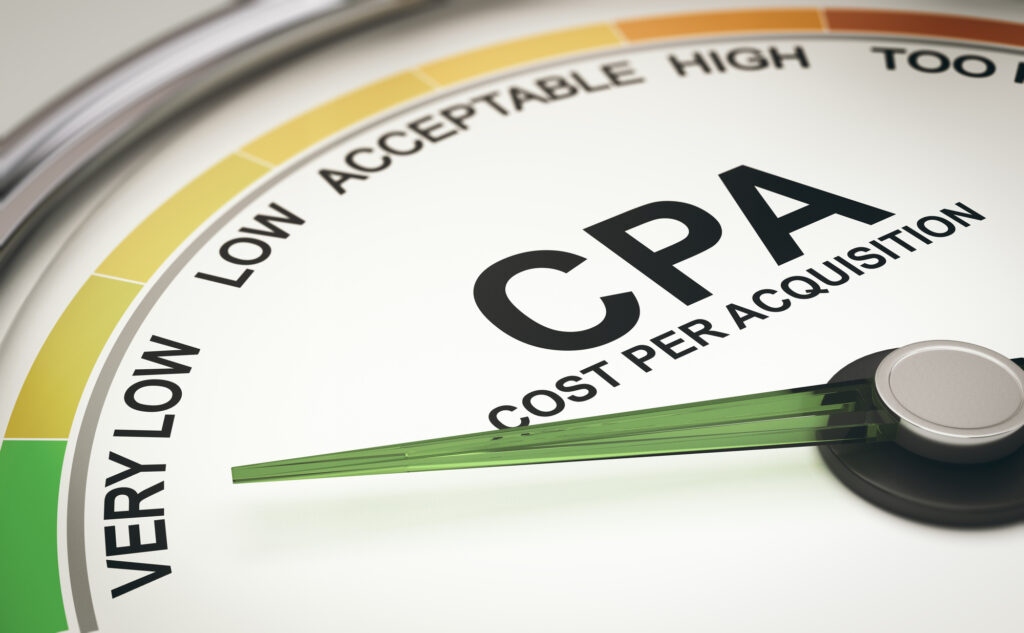CPA, or Cost Per Acquisition, is a popular performance-based pricing model used in digital marketing. It’s a metric that measures the cost of acquiring a new customer or lead through a specific marketing channel.

Understanding Cost Per Acquisition: A Basic Breakdown
In simple terms, CPA is the amount you pay for each customer or lead generated through your marketing efforts. It’s a direct way to assess the effectiveness of your campaigns and determine the return on investment (ROI).
How to calculate Cost Per Acquisition?
The CPA calculation is straightforward:
CPA = Total Cost of Campaign / Number of Conversions
For instance, if you spend ₹10,000 on a campaign and acquire 100 new customers, your CPA would be ₹100 per customer.
Types of Cost Per Acquisition Models
There are different CPA models that you can consider:
- Hard CPA: This involves paying for each completed purchase or sign-up.
- Soft CPA: This involves paying for leads that meet specific criteria, such as filling out a contact form or downloading an ebook.
- Hybrid CPA: This combines elements of hard and soft CPAs, offering flexibility in tracking and payment.
Understanding Different CPA Models
CPA or Cost Per Acquisition, is a popular pricing model used in digital marketing. It measures the cost of acquiring a new customer or lead through a specific marketing channel. There are different types of CPA models that businesses can consider:
- Hard CPA
What it is: In a hard CPA model, you only pay for each completed purchase or sign-up. This means that if someone clicks on your ad but doesn’t make a purchase, you don’t pay anything.
Example: Let’s say you’re running an online store selling shoes. If someone clicks on your ad, visits your website, and buys a pair of shoes, you would pay the CPA for that purchase. If they only browse your website but don’t buy anything, you wouldn’t pay anything. - Soft CPA
What it is: A soft CPA model involves paying for leads that meet specific criteria, such as filling out a contact form or downloading an ebook. These leads may not have made a purchase yet, but they are considered potential customers.
Example: If you’re a software company offering a free trial, you might use a soft CPA model. You would pay for each person who signs up for the free trial, even if they don’t purchase the full version. - Hybrid CPA
What it is: A hybrid CPA model combines elements of both hard and soft CPAs. This offers flexibility in tracking and payment.
Example: You could use a hybrid CPA model where you pay for both completed purchases and leads that meet specific criteria. For example, you might pay a higher CPA for a completed purchase and a lower CPA for a lead who downloads a free ebook.

Which Cost Per Acquisition Model is Right for You?
The best CPA model for your business depends on your specific goals and budget. Here are some factors to consider:
- Your products or services: If you’re selling high-value products or services, a hard CPA model might be more suitable. If you’re offering free trials or lead magnets, a soft CPA model could be a good option.
- Your marketing goals: If your goal is to generate leads for future sales, a soft CPA model might be more effective. If you’re focused on immediate sales, a hard CPA model could be better.
- Your budget: Hard CPAs can be more expensive, as you’re only paying for completed purchases. Soft CPAs can be more affordable, as you’re paying for potential customers.
By understanding the different types of CPA models, you can choose the one that best aligns with your business objectives and helps you achieve your marketing goals.
CPA in the Context of Digital Marketing
CPA is particularly relevant in digital marketing due to the ability to track and measure various online activities. Common channels where CPA is used include:
- Search Engine Marketing (SEM): Paying for clicks on ads that appear on search engine results pages.
- Social Media Marketing: Paying for clicks or impressions on social media ads.
- Email Marketing: Paying for clicks on links within emails.
- Affiliate Marketing: Paying a commission to affiliates for each referral that results in a conversion.
Search Engine Marketing (SEM)
How it works: When you run ads on search engines like Google or Bing, you pay a certain amount each time someone clicks on your ad.
CPA calculation: The CPA for SEM is calculated by dividing the total cost of your ads by the number of clicks that result in a conversion (e.g., a purchase or signup).
Social Media Marketing
How it works: You can create ads on platforms like Facebook, Instagram, Twitter, or LinkedIn and pay for clicks or impressions on those ads.
CPA calculation: The CPA for social media marketing is calculated by dividing the total cost of your ads by the number of clicks or impressions that result in a conversion.
E-mail Marketing
How it works: You can send emails to your subscribers and include links to your website or products. You can pay for clicks on those links.
CPA calculation: The CPA for email marketing is calculated by dividing the total cost of your email campaigns by the number of clicks on links that result in a conversion.
Affiliate Marketing
How it works: You partner with affiliates who promote your products or services in exchange for a commission. When an affiliate refers a customer who makes a purchase, you pay the affiliate a commission.
CPA calculation: The CPA for affiliate marketing is calculated by dividing the total cost of affiliate commissions by the number of referrals that result in a conversion.
In all of these channels, CPA is a valuable metric for measuring the effectiveness of your marketing efforts and determining the cost of acquiring new customers or leads.
Benefits of Using a CPA Model
Performance-Based: You only pay for results, ensuring that your marketing efforts are directly tied to conversions.
Measurable: CPA provides a clear metric to track the effectiveness of your campaigns and identify what’s working and what’s not.
Targeted: You can focus your resources on channels and tactics that deliver the best results, optimising your marketing spend.
Scalable: CPA allows you to adjust your spending based on your acquisition goals. in addition, if you’re acquiring customers at a lower cost than your target CPA, you can increase your spending to acquire more customers. Conversely, if the cost is higher than your target, you can reduce your spending or optimise your campaigns.
Challenges of Using a CPA Model
Cost: CPA can be expensive if you’re acquiring high-value customers.
Quality: It’s important to ensure that the leads or customers you acquire are of high quality.
Attribution: Determining the exact source of a conversion can be challenging, especially in multi-channel campaigns.
CPA and Nagpur's Digital Marketing Landscape
Nagpur, as a growing city with a vibrant digital marketing scene, offers numerous opportunities for businesses to leverage CPA models. Moreover, local Digital Marketing Agencies in Nagpur and Digital Marketing Companies in Nagpur can help you implement effective CPA strategies.
How to reduce cost per acquisition? Tips for Optimising CPA
- Set Clear Goals: Define your target CPA and track your progress regularly.
- Target the Right Audience: Use audience segmentation to reach potential customers who are most likely to convert.
- Create High-Quality Content: Engaging and relevant content can improve conversion rates.
- Test and Optimise: Continuously experiment with different campaigns and landing pages to find what works best.
- Utilise Tracking Tools: Use analytics tools to monitor your CPA and identify areas for improvement.
Conclusion
CPA is a valuable metric for businesses looking to measure the effectiveness of their digital marketing efforts. By understanding the principles of CPA and leveraging the expertise of local Digital Marketing Agencies in Nagpur, you can optimize your campaigns and achieve your acquisition goals.
